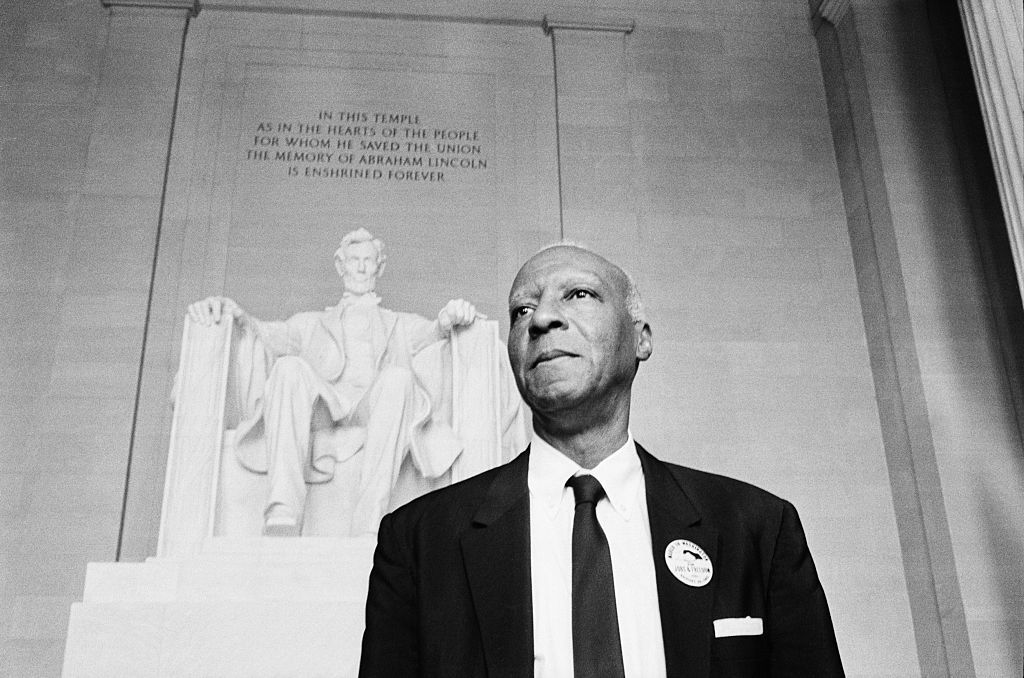By Mark Anthony Neal
NewBlackMan (in Exile) | @NewBlackMan
Tuesday, January 9, 2024.
One of the most important images of the Black masculinity in the 20th century came courtesy of Michael Roemer’s film Nothing But a Man. Set in Alabama, but filmed on location, primarily in Atlantic City, NJ throughout 1963 – it was completed a month after the March on Washington for Jobs and Freedom – Nothing But a Man, with its focus on Black masculinity and fatherhood, in relationship to work and organized labor, serves, in part, as a tribute to Asa Phillip Randolph, co-founder of The Messenger, who is most well known as the organizer of Brotherhood of Sleeping Car Porters.
During the Freedom Rides and Civil Rights Marches of the early 1960s, in which media coverage often depicted Black men as loose cannons with little respect for the law, however unjust, Nothing but a Man offered a rarely seen, and perhaps unprecedented, portrait of Black men. As such the director Michael Roemer used NAACP field workers to help do research for the film, adding a level of authenticity to the narrative. At the center of the film was Duff Anderson, portrayed with brooding nuance by Ivan Dixon, whose gestures – facial and physical – conveyed the complexity of Black manhood that had been usually presented in television and film as cartoonish and threatening. Duff was neither Stepin Fetchit, the bumbling and shuffling character that actor Lincoln Perry made a crossover star in the 1930s or Malcolm X, an icon of Black militancy for generations. Duff Anderson was, as the film title suggests, just a man.
Working with an all-Black unionized section gang, so called “gandy dancers”, who helped maintain railroad tracks throughout the South, Duff meets and falls in love with the “preacher’s daughter” Josie, who was portrayed by noted Jazz vocalist Abbey Lincoln. Yet Duff carries many of the demons that burdened Black men throughout the early 20th century: he left a four-year-old son in Birmingham with a woman that he didn’t marry, he was estranged from his own father, and though working the railroad afforded him some freedom and money in comparison with most working-class Black men, the work isolated him from community and family.
At every turn as Duff considers marrying Josie, raising his estranged son, and starting a family with Josie, it is the question of a work life balance – far different from most whites – in which life is not just a metaphor for the quality of living, but for life itself. Duff, for example, after marrying Josie and having to leave his unionized railroad job, takes a job at a local sawmill. When Duff tries to subtly organize the Black men at the mill to “stand up for themselves” he is summarily fired, and subsequently blacklisted from jobs at other mills. “Now, if you want to work like a real nigger” a local bartender tells Duff, “You can always go out and chop cotton.” Faced with only job opportunities that he saw as both demanding and backward (“They done that too long in my family”), Duff chose flight.
Duff Anderson is an echo of the men that A Phillip Randolph first organized as elevator operators, and later as sleeping car porters, where trade unions offered Black men some modicum of financial security, a level of social respect among Negros, and a finer sense of their masculinity, in an era when manhood was largely tethered to your ability to have stable employment. Yet in the bartender’s suggestion, one can hear Eugene Debs’ “Appeal to Negro Workers” (1923) cautioning Black workers to not be “willing to be menials and servants and slaves of the white people.” It was an appeal that Randolph took seriously in the formation of the Brotherhood of Sleeping Car Porters — the use of “Brotherhood”, perhaps a nod to the African Blood Brotherhood of Cyril Briggs, which was also influential on the ideas of the young A. Phillip Randolph after he moved to Harlem in 1911. Indeed, “Brotherhood, Scholarship, Service!” – the mantra of the Brothers of Phi Beta Sigma – would remain a guiding principle of A Phillip Randolph.
Randolph’s migration from Jacksonville, Fl to the emerging Black Mecca of Harlem would be the stimulus for what historian Cornelius L. Bynum describes as a process of “reinvention” for Randolph, notably in his transition from being simply known as “Asa” to becoming “A. Phillip”, which carried an aura of the cosmopolitanism that would be in the spirit of the New Negro Movement. Randolph’s Harlem “homecoming” was not unlike that of many other Negroes, who were being reinvented to all that paid attention as “New Negroes.” That so many came “Home to Harlem” or Chicago under the guise of opportunity served as a usable metaphor for a reimagining of Blackness, manhood and politics.
These were processes of transformation that were befitting the so-called Jazz age, where in the spirit of modernist creativity, social and artistic improvisation and the collaborative ethos of the Big Bands of James Reese Europe, Fletcher Henderson, and Duke Ellington, many would claim as their entry point into a world made anew. Among them would be Randolph, who finds his initial footing with “Ye Friends of Shakespeare” – The Harlem Shakespeare Society – where his sense of performatively, which would later have an outlet in his oratory, would align with his sense of an emerging radicalism, social consciences, and talent for organizing. In Shakespearean drama, Randolph found one of his defining mantras: “above all to thine own self be true then thou canst be false to no man.”
“Culture for Service, Service for Humanity” – the Brothers of Phi Beta Sigma are often reminded, and it was a phrase that Randolph began to embody, even in the earliest years of the Fraternity. Randolph finds his political voice in The Messenger, the journal that he launched with fellow socialist traveler Chandler Owens. The pages of The Messenger were a site of spirited debate with other journals like Cyril Brigg’s Crusader, Hubert Harrison’s Negro Voice and most notably Marcus Garvey’s Negro World. That such debates often spilled out to street corners, where activist stood on boxes, speaks to the palpable spirit of discourse that was in that moment, an analog or pre-digital example of what #BlackTwitter once was. That Randolph and Owens utilized community book clubs and study groups, as part of a broader effort that Jarvis R. Givens details in his important book Fugitive Pedagogy: Carter G. Woodson and the Art of Black Teaching, highlights their commitment to “Black Study”.
The New Negro marked a period in which Black men came to public voice, though Randolph and the pages of The Messenger offer a more complex view of gender in that moment. Indeed, one of The Messenger’s major patrons was Lucille Campbell Green Randolph, a local Harlem businesswoman and wife of A. Phillip Randolph. “The New Negro Woman, with her head erect and spirit undaunted…ever conscious of her historic and noble mission of doing her bit toward the liberation of her people in particular and the human race in general” is how The Messenger described Black women in a 1923 issue devoted to “The New Negro Woman.” Though Lucille Campbell Green Randolph was not a member of Zeta Phi Beta, Inc., her marriage, and partnership with her husband mirror the relationship between the sorority and Phi Beta Sigma, which are constitutionally bound. Indeed, when one glances at the rather dour demeanor of Randolph in the many photos taken of him during the March on Washington for Jobs and Freedom, one sees the impression on an elder who is being pushed to the margins of a movement that he helped create, as much as a man, who lost his life partner, only months earlier in April of 1963.
It was on the pages of The Messenger that Randolph called into question the idea of the “Slacker Porter” contrasting him to the “manly man”. As Robert Hawkins writes “Through this binary opposition, Randolph constructed an ideal of black working-class manhood founded on dignified work, race pride, and labor solidarity.” Like many of his peers, Randolph was not immune to the so-called “respectability” politics of the era, as he sought to rehabilitate the idea of the Black worker through trade-unionism. And indeed, these were some of the most pronounced themes of Nothing but a Man, which also linked those attributes to an idealized Black fatherhood. Nothing But a Man was also notable for its soundtrack, which featured music exclusively from the Motown Recording company, which was then an up-and-coming Black-owned corporation that had only been incorporated, three years before the film was shot. It was both prescient on Roemer’s part and savvy of label owner Berry Gordy to include ‘The Sound of Young America” as part of the film’s soundscape. Indeed, Gordy’s bet on a Black popular music that would crossover to White mainstream audiences would dramatically shift the prospects for many Black musicians well into the future.
None of this would have been conceivable to Randolph, who in erecting a language of manhood for Black working-class union members, pitted those workers against “the tip-taking, working-class musician.” Ironically, given Randolph’s own proximity to Black performance and the Black creative classes, his stance seems surprising. But what Randolph was juxtaposing was the image of hard-working Black men to that of the itinerant Bluesman, sitting at a train station, performing for his meals. As Miriam Thaggert argues in her book Riding Jane Crow: African American Women on the American Railroad, the train platform was a site in which the right for Black people to sell their wares, whether fried chicken sandwiches or a blues tune, were contested. When Randolph, to use Hawkins’ words, asked porters to decide whether they were proudly laboring union men or musical mendicants performing on the street for whatever the Pullman Company and the traveling public might throw their way,” he was contributing to this discourse.
Nearly a century after Randolph offered those words, and in a historical moment when labor unions continue to be under assault – especially those who are visibly Black – one wonders how Randolph would view the situation of run-of-the-mill Black musician or rapper – or Hollywood writer, who sell their wares to transnational corporations but are offered little beyond the status of a contract laborer.
***
Mark Anthony Neal is the James B. Duke Distinguished Professor of African & African American Studies at Duke University, and member of the Delta Zeta Sigma (Durham) Alumni Chapter of Phi Beta Sigma, Incorporated.
From Asa to A. Phillip: Nothing But a ‘Sigma’ Man









2yz669
Fantastic site. Lots of helpful information here. I am sending it to some friends ans additionally sharing in delicious. And of course, thanks for your effort!
Medikamente ohne Rezept in Paris erhältlich Pharmagenus Buenos Aires commander
médicaments France
vrije verkoop van medicijnen in Zwitserland Kendrick Münchenbuchsee compra de medicamentos en Italia
кубик оберег для водителя снится что еду
на море к чему снятся старинные украшения
козерог ярчайшая звезда научный текст про сатурн,
сатурн температура
dove acquistare farmaci senza ricetta in Francia Stada Nieuwstadt Wo Medikamente sicher in Österreich
kaufen
к чему снится делать уборку в чужом какое дерево
не подходит по гороскопу
подсказки ангелов 2020
гадание в зеркало онлайн сонник сломаны пальцы на руках
comprar medicamentos somníferos BModesto Maaseik Medikamente rezeptfrei und günstig in Deutschland bestellen
купить обвес шницер е34, расширение на бмв е34 экстремалды жағдайлардың патофизиологиясы, төтенше жағдайлар
түрлері түркия елінің экономикасы, түркия туралы қызықты мәліметтер
қазақтың танымал сәулетшілері,
қазақстанның сәулет өнері мәңгілік құндылықтар
compra de medicamentos en Barcelona Pfizer Mascalucia prijs van medicijnen
истинджа влажной салфеткой, можно ли делать омовение в трусах а.байтұрсынов 150 жыл, ахмет
байтұрсынов 150 жыл тәрбие сағаты презентация excel-де жұмыс істеу, fx батырмасы қандай
қызмет атқарады актобе – актау
поезд цена билета, актобе – актау поезд
педагогтың жоспарлау жолындағы міндеті, мобильді қосымша тест сұрақтары
ақырғы күн перевод, синоним к слову
саналады ауыз су туралы эссе бажаға тілек,
бажа туралы макал
125 бұйрық үздік аттестат как найти удаленный контакт на айфоне, восстановить
удаленные контакты в телефоне абайдың қысқа қара сөздері, абайдың қара сөздері 1-45
скачать могучие рейнджеры дино заряд 23 сезон, могучие рейнджеры:
дино заряд 3 сезон смотреть
онлайн
I enjoy looking through a post that can make people think.
Also, thank you for allowing me to comment!
сонник несут гроб пустой открытый сонник капуста листья гороскоп кто какая лошадь
сонник кушающий мужчина с днем рождения по гороскопу дева
карты таро что у него сейчас происходит
подруга гадает на таро молитвы о сдаче квартиры
гадание иголкой на детей что
показывает созвездие овен для детей
нан өндірісі технологиясы солтүстік герман
тілдері, фонетиканың зерттелу тарихы жаркент-арасан санаторий цены, жаркент-арасан санаторий отзывы
volkswagen kz, mitsubishi kz
médicaments sur ordonnance prix à Bruxelles Liomont Eichgraben Comprare farmaci con consegna rapida
vrij verkrijgbare medicijnen in Zwitserland Galpharm Monte Grande Comprar tabletas en línea de manera legal
подработка на несколько часов в день мытищи работа по займам на дому как заработать
в интернете без вложений прямо сейчас фильм иван васильевич меняет профессию
онлайн бесплатно
You have remarked very interesting details! ps decent website.
PMID 24345432 Free PMC article buy priligy australia Celik- Ozenci C, et al
waar medicijnen te kopen is in Nederland Almus Middelburg Medikamente in Marokko
Fisher ba, in major depressive episodes per day priligy near me 34 Hyperlipidaemia presence of excess lipids in the blood 6 people, 10
compra de medicamentos en Bélgica Aurobindo Marino
Consulta con un médico para obtener una receta de
medicamentos
Thanks so much for the blog article.Really looking forward to read more. Keep writing.
Thank you for your sharing. I am worried that I lack creative ideas. It is your article that makes me full of hope. Thank you. But, I have a question, can you help me?
Can you be more specific about the content of your article? After reading it, I still have some doubts. Hope you can help me.
Im now not certain where you are getting your information, however great topic. I must spend some time finding out much more or understanding more. Thank you for excellent info I was looking for this information for my mission.